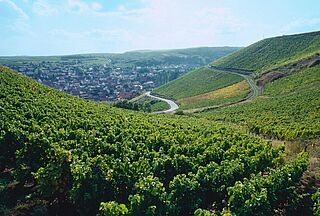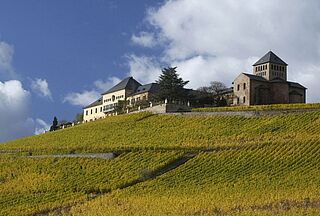Johannisberg
Kendte vinmarker
Johannisberg - Famous Name in the Rheingau...and in the Nahe Region
This months famous vineyard site is located in the heart of the Nahe wine-growing region, in Wallhausen, a thousand-year-old wine village situated some 10 km (6 miles) northwest of Bad Kreuznach in the Gräfenbach Valley (a Bach is a stream or brook).
It lies between ancient castle ruins and vineyards in Dalberg and Gutenberg, in an area once traversed by an old Roman trade route from Paris to Trier to Bingen, Mainz, Frankfurt and beyond. An old boundary stone in Wallhausen bears witness to its Roman past.
The vineyards in and around Wallhausen are some of the oldest documented vineyards of Europe, first listed (without specific names) in an estate land register of the Barons of Dalberg in 1200. The Dalbergs (formerly named Weierbach) began building their impressive hilltop Dalburg (castle) in 1150, and it was their home for generations. The first documented mention of the Dalbergs’ specific vineyard site names – including Johannisberg – dates from 1501.
The Dalbergs’ administrative center was housed in their castle in the valley (Wallhausen), which was transformed into living quarters for the family in 1756. Schloss Wallhausen is the home of Dalberg descendants to this day – Michael Prinz zu Salm-Salm, proprietor of the wine estate Weingut Prinz zu Salm-Dalberg. The last Dalberg was Prinz Salm’s grandmother, who married Franz Prinz zu Salm-Salm in 1911, and hence the merger of the names Dalberg and Salm. Many of the estate’s wine labels depict the ancestral Dalburg castle, based on a copper engraving made by the renowned 17th-century artist Matthias Merian. The extensive ruins (1 km/half mile from Wallhausen) are open to the public and afford a wonderful view of the countryside.
The “Value” of the Vineyards
During the first third of the 19th century, the Prussian government began to systematically survey its holdings – including vineyards – west of the Rhine to assess their value for property taxes. The results of their initial surveys were updated in the 1860’s, and again at the end of the 19th century – this time with the assistance of local vintners. When the final survey was completed in 1901, the findings were documented in a map in which the vineyards were categorized according to their value, with each of the three categories printed in a different color. Wallhäuser Johannisberg numbered among the most valuable sites.
In all, the Prussians’ meticulous work yielded a classification of vineyard sites...a subject of ongoing debate that was addressed by British wine writers Hugh Johnson and Stuart Pigott – staunch advocates of an official classification of Germany’s vineyards – who “updated” the famous map of 1901 and published their data in their Wine Atlas of Germany (1995). Although there had been changes in the course of the 20th century, the maps of 1901 and 1995 are remarkably similar, i.e. the sites that the Prussians had deemed most valuable in the early 19th century were the very sites still yielding superb wines at the end of the 20th century!
Changing Fate in the Wallhäuser Johannisberg Site
Although Johanisberg has long been recognized as a top site in the Nahe wine-growing region, it has suffered the fate of many a steep, labor-intensive site in German wine country: during the past 30 years it has gradually been abandoned. In a standard reference work on German vineyards published in 1979 (Vinothek der Deutschen Weinberg-Lagen), Wallhäuser Johannisberg comprised 25 ha (62 acres). According to current statistics of the local agricultural chamber, there are barely 7 ha (17 acres) of productive vines in the site today. The regional “DLR” (rural service center) confirms that more than 50% of the vineyard lies fallow – but an ambitious project to help remedy the situation is about to begin this summer.
In an attempt to encourage growers to resume viticulture in the site, there are plans to improve the lay of the land (through grading) and access to the vines (install more paths) so that mechanical aids can be used for maintenance work. In the steep portions of the site, the historical stone terrace walls will be repaired – they are part of the traditional viticultural landscape. Here, however, much (if not all) vineyard work will still have to be done by hand. As Constantin Salm pointed out, there is not enough room on small terraces for a tractor to turn around. Last but not least: to keep abandoned parcels cleared so that they can be replanted with vines, goats and sheep will be brought to the site – environmentally friendly “lawn mowers.” These measures could restore up to 10 ha (25 acres) of land available for viticulture in the site.
Funding for the project comes from the EU, Germany, the state of Rheinland-Pfalz, Wallhausen and local wine-growers. It is hoped that the fallow portions of the site will be ready for replanting by 2009 or 2010.
Natural Features
Wallhausen’s vineyards are protected from rain and wind by the Soon (pronounced “zone”) and Hunsrück forests. The weather is generally not as cold in winter as in neighboring sites to the north or east. Here, as throughout the Nahe region, the soils are extremely varied. Johannisberg is marked by Rotliegendes (reddish mixtures of clay, slate and sandstone) topped by slightly loamy gravel or stony-gravelly loam. The best parcels face south or southwest. Half of the site is sloping and half is extremely steep (up to 60% incline).
Riesling is the primary grape variety (ca. 64%). The remaining 36% of the vineyard is planted with red and white Pinots (Spätburgunder, Grauburgunder, Weissburgunder) and small amounts of other varieties.
The Prinz zu Salm-Dalberg estate has the largest holdings in the site (2 ha/5 acres) and has cultivated its vines organically since 1989 (certified since 1995). Their oldest vines are over 50 years old, with roots that are 20 meters deep. According to Constantin Salm, they were planted on the day his father, Prinz Michael, was born in 1953 – after which there was a great celebration at the estate. A few weeks ago there was also reason to celebrate: two wines from Wallhäuser Johannisberg made news in the American wine magazine Wine Spectator: 2005 Riesling Auslese was awarded 93/100 points and 2005 Riesling Trockenbeerenauslese received 99 points!
Festivals & Spas
The Rotweinfest (red wine festival) in mid-May at Schloss Wallhausen and the Kirmes & Weinmarkt in mid-August are the town’s main festivals. There are, however, other cultural events in Wallhausen throughout the year, many of which take place at wine estates.
Although Wallhausen is not a spa, it is not far from three: Bad Kreuznach, Bad Münster am Stein-Ebernburg and Bad Sobernheim. All three are also sites of festivals and wine-related events. The Römerhalle (Romans’ Hall) in Bad Kreuznach houses Roman artifacts and mosaics worth seeing. It is also the venue of an important annual wine auction in late September. Bad Sobernheim has two outdoor attractions: the Barfusspfad (barefoot path), a 3.5 km (2 mile) walk on different surfaces (grass, stones, sand, clay, mud) that crosses the Nahe River twice (you can leave your shoes in lockers on site), and the open-air Freilichtmuseum, a reconstructed country village that shows the region’s typical architecture and way of life in former times.
Good Wine & Food
The Nahe’s most famous chef de cuisine (and TV personality) is Johann Lafer. He and his wife run Johann Lafer’s Stromburg, a first-class hotel (13 rooms, 1 suite) with a gourmet restaurant, Le Val d’Or, and less formal Turmstube. The wine list is superb and features more than 200 top wines from the Nahe. The gourmet restaurant is closed Mondays and no lunch weekdays. Turmstube is open daily for lunch and dinner. Am Schlossberg 1, 55442 Stromberg (12 km/7.5 miles north of Wallhausen, via Hergenfeld and Schoneberg). All credit cards.
Weinstube Kruger-Rumpf is at the wine estate of the same name. Cornelia Rumpf prepares refined country cooking at its best; Stefan Rumpf is a highly respected winemaker. Exposed beams make for a cozy setting indoors; the flower-filled courtyard is a favorite in summer. Closed Mondays and open for dinner only. Rheinstrasse 47, 55424 Münster-Sarmsheim (15 km/9 miles northeast of Wallhausen, via Windesheim and Autobahn 61; 10 minutes west of Bingen). MC, Visa
Erno Dietz’s Landhaus Dietz on Wallhausen’s main street also offers tasty country fare and is well-known for game dishes. In autumn, they serve the regional specialty Spansau (roast suckling pig). The first Friday of the month: Weinmenü, a six-course dinner with local wines presented by the winemaker. In summer, dine alfresco in the “Weingarten.” Closed Mondays. Weekends open from 11 a.m. (non-stop) til evening; weekdays, lunch 11 a.m.–2 p.m. and dinner after 5 p.m. Hauptstrasse 14, 55595 Wallhausen. No credit cards.
Many thanks to Constantin Prinz zu Salm-Salm, Weingut Prinz zu Salm-Dalberg (www.salm-salm.de), for answering countless questions about Wallhäuser Johannisberg and providing the photo.


